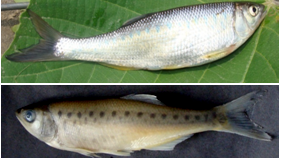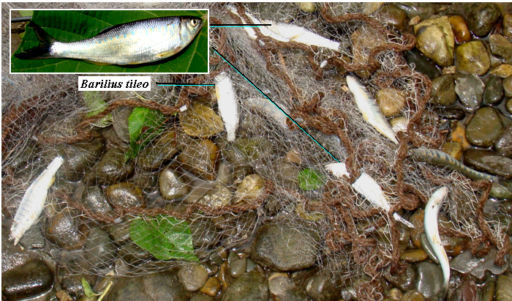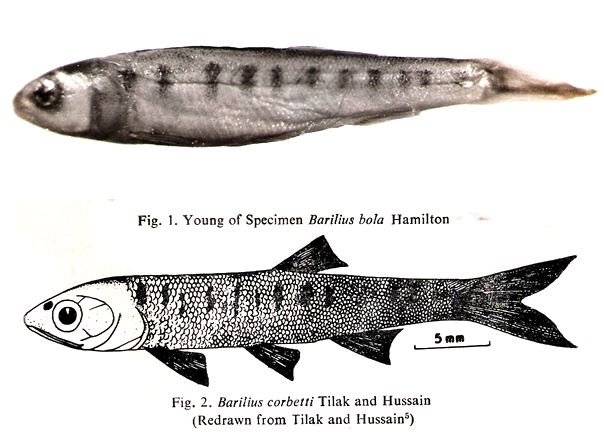Live specimen of Barilius telio. Mark the presence of oblong bluish spots on the flank, upwardly directed mouth; yellowish pectoral, pelvic and anal fins; black edged dorsal fin and longer lower lobe of the caudal fin.
Interestingly, in the streams of Eastern Doon (Uttarakhand), specially River Song at Teen Paani (at Golatappar swamp forest, in Barakot forest range, close to Raiwala, about 50 km from Dehradun city), flowing through forest thickets on the clayey, rocky and pebbly bed, harbours two ‘TROUT LIKE’ species which, though different in their body profile and total length range, similarly exhibit the presence of 2 or more rows of bluish spots/ blotches along sides. They can be easily characterized into species belonging to 2 different Genera viz., Barilius tileo (10.0 – 18.0 cm) and Raiamas bola (10.0 – 29.5 cm), on the basis of the following:
Barbels 2 pairs:
Trout like, compressed laterally, ventral profile more arched than the dorsal. Cleft of mouth deep and directed upwards. Barbel 2 pairs, one small rostral and one small maxillary pair; rostral originating slightly anterior to the anterior border of the nostril and about the middle of the snout length at a point where a suture separates pre-orbital and nasal bone; maxillary pair originating a bit prior to the end of maxilla and to below about 1/4th of the diameter of eye. Bluish-brown along the dorsum, becoming silvery on the flanks and belly; with 2 – 4 irregular rows of vertically oval bluish black blotches of varying sizes on the sides, 14 – 16 being in the first row. Dorsal fin greyish. Pectoral, pelvic and anal fins lemon yellow. Caudal fin greyish, more so on the lower lobe. There is a well-marked sexual dimorphism, males with tubercles at the lower mandibular surface, snout and scales; Ist unbranched ray and I and II branched rays of pectorals being osseous and thickened.
……. Barilius telio

(Expand/Collapse the below section by clicking on (+-) symbol for details…
Barilius tileo Mark silvery body with yellowish fins, tinged orange-red. Oblong spots on the flank shaded by silvery hue.

Barilius tileo (After preservation): Mark the 15 – 16 oblong spots in the first row on the flank and upwardly directed oblique mouth.
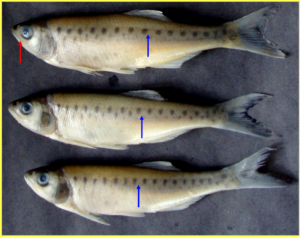
Barilius telio: Head of male enlarged, showing 2 pairs of barbels and tuberculations on the snout and lower jaw.
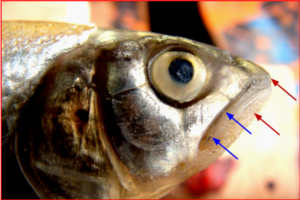
Barilius telio: Head of male enlarged from lower side, showing extent of rough tuberculations (with pointed tips) on the lower jaw.
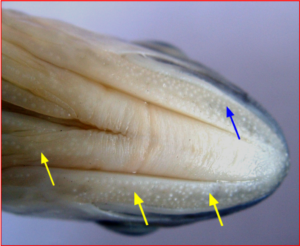
Barilius telio: Head of female enlarged from lower side, showing less prominent and smooth to touch tuberculations on the lower jaw. Also mark the presence of a smaller maxillary barbel.
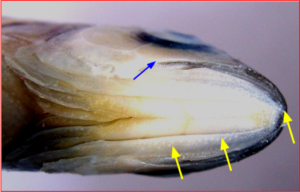
Barilius telio: Pectoral fins of male in ventral view, showing osseous and thickened I unbranched ray and I and II branched rays.
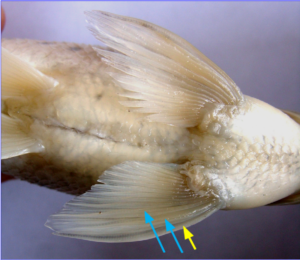
Barbel 1 pair:
Body trout like, long, sub cylindrical and slender. Barbel 1 pair, very short maxillary, just above the angle of jaws. Cleft of mouth deep (salmon like), directed obliquely upwards. Lower jaw with a symphyseal knob, fitting into a medial notch of the upper jaw. Silvery-greyish (or steel grey) with 3 – 5 rows of blue-green irregularly arranged oblong blotches on the sides, may be extending up to head, 14 – 16 in the first row, the blotches of the successive rows showing an alternate arrangement.
Having a ‘least concerned status (IUCN, 2011)’, it comfortably frequents the serene Song River stretch in the Golatappar forest swamp region, not much disturbed by anthropogenic activities. The maximum size recorded was about 29.5 cm, the same as observed by Hora and Mukerji (1936) more than 80 years ago when they described ‘Fishes of the Eastern Doon’.
…………..Raiamas bola (= Barilius bola) [Famous as Doon Hill Trout]
Fully grown (29.5 cm) steel grey Raiamas bola from Song River (Teen Paani, Golatappar forest swamp, Eastern Doon).
Presence of Barbels in Raiamas bola !!
Wikipedia [https://en.wikipedia.org>wiki>Trout barb] states that “The juvenile fish possess a pair of rudimentary maxillary barbels but these are absent in the adults”.
Similarly, https:///www.fishbase.se>summary>Raiamas bola says “do not have barbels”.
Both the statements need correction, as the presence of barbel has been noticed here in a specimen (about 29.5 cm) from Eastern Doon (Uttarakhand), which definitely is not a juvenile. Presence of barbel had also been noticed in the specimens studied, from upper plateau segment of river Ken (Banda district, UP, India) way back during 1977 – 1982, the young specimens (3.6 – 5.9 cm) also showing similar presence.
A study on the young specimens of Raiamas bola (=Barilius bola)
While studying the fish fauna of Banda district (Uttar Pradesh, India), adult (16.6 – 21.0 cm) and young specimens (3.6 – 5.9 cm) were examined and synonymous nature of Barilius bola and Barilius corbetti (Tilak and Hussain, 1980) was discussed in a communication entitled, ‘On the Barilius bola Hamilton from Banda district (UP) and its new synonym’, published in 1983 in Proc. Nat. Acad. Sci. India, Vol. 53(B)IV:313 – 317
Raiamas bola: One of the young specimens collected (and studied during 1977 – 1982) from river
Ken (Banda district, Buldelkhand, Uttar Pradesh, India)
More photographs of Raiamas bola from Eastern Doon
[TEEN PAANI, GOLATAPPAR, UTTARAKHAND, INDIA] AS WELL AS FROM BANDA DISTRICT [BUNDELKHAND, UP, INDIA]
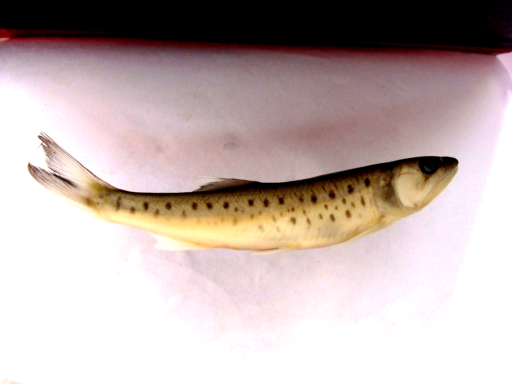
(Expand/Collapse the below section by clicking on (+-) symbol for details…
Raiamas bola (Preserved specimen) Mark the presence of oblong spots on the flank and upwardly directed mouth.
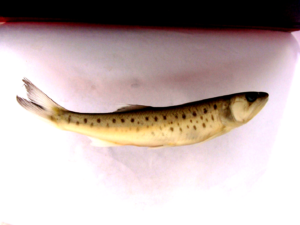
Raiamas bola: Head enlarged to show the extension of black blotches up to head and a very small maxillary barbel.
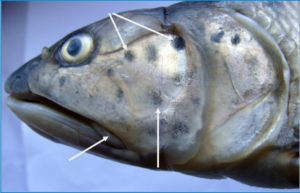
Raiamas bola: Head enlarged, showing a very small maxillary barbel [b] in specimens studied at Banda (Uttar Pradesh, India) way back in 1977.
![Raiamas bola: Head enlarged, showing a very small maxillary barbel [b] in specimens studied at Banda (Uttar Pradesh, India) way back in 1977.](http://www.fishbiopedia.com/wp-content/uploads/2019/12/GrMNgW-1-300x174.png)
Raiamas bola: Head enlarged, showing a very small maxillary barbel, a symphyseal knob on the lower jaw and a median notch in the upper jaw for lodging the knob.
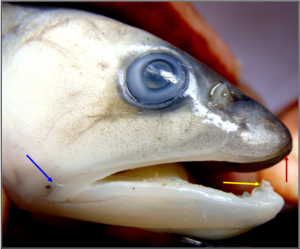
Raiamas bola: Head enlarged, showing a very small maxillary barbel and the symphyseal knob fitting into the median notch of the upper jaw.
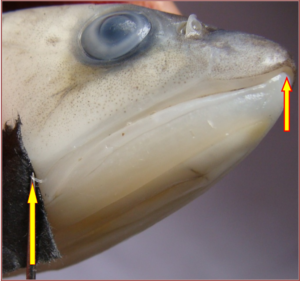
Habitat
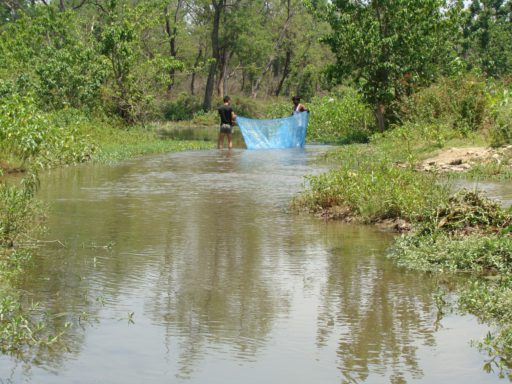
The habitat photographs, the preferred dwelling sites of Barilius telio and Raiamas bola in Eastern Doon, Uttarakhand, India
(Expand/Collapse the below section by clicking on (+-) symbol for details…
(Golatappar Range, Doon Valley, Uttarakhand), favourite dwelling site for Barilius telio.
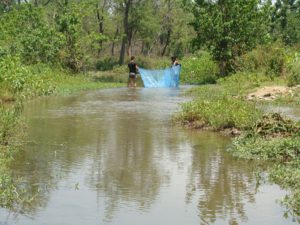
River Song: A stretch at Raiwala (Doon Valley, Uttarakhand), favourite dwelling ground of Raiamas bola and others like Tor, Labeo, Chagunius, Garra, Barilius, Xenentodon sp. etc.
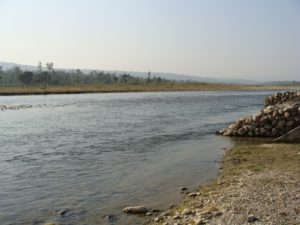
River Song: A stretch at Teen Paani, Eastern Doon (Galatappar, Doon Valley, Uttarakhand), a favourite dwelling ground for Barilius bendelisis, B. vagra, B. barna, B. telio, Raiamas bola, Labeo, Tor, Garra, Glyptothorax sp. etc.
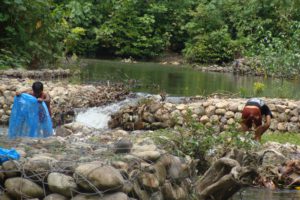
The Song River flowing downstream towards Ganga at Raiwala
Song River: Flowing downstream towards Ganga at Raiwala
- Systematic position:
Family: Cyprinidae
Subfamily: Rasborinae
(= Danioninae)
- Barilius tileo
- Raimas bola
- Most common in Golatappar Teen Paani stretch of Doon valley, Uttarakhand, India
Compilation by Dr. SK Gupta.
Instant Identification of Indian Freshwater Fish in the Field
